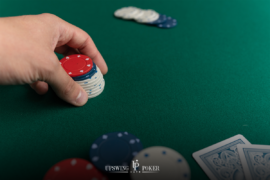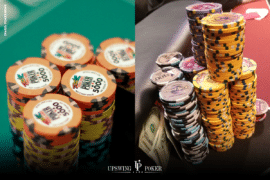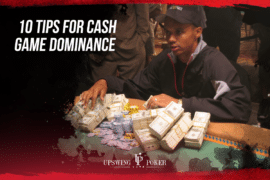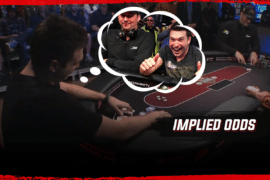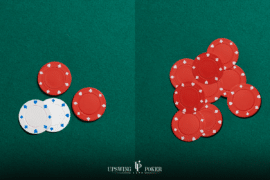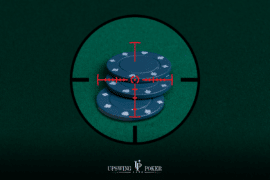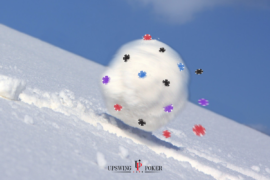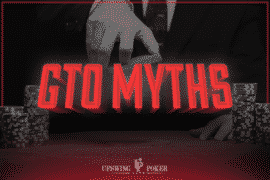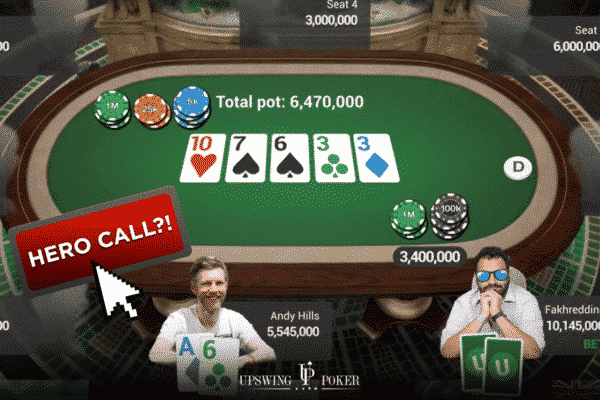
14 Players Away from €300,000 — Should He Hero Call This Hand?
When your opponent either has the nuts or nothing, it can make sense to bluff-catch with a marginal hand.
Today’s hand is an example of such a situation.
In October 2018, The Battle of Malta boasted a then-record field of 3,816 players. British tournament specialist Andy Hills made it to the final table but, on his way there, he faced an excruciatingly difficult decision versus the chip leader, Abdalah Fakhreddine.
Watch the video review of the hand here, or keep reading for a written recap and analysis:
Editor’s Note: This article is by Irish tournament pro and Unibet Poker ambassador David Lappin who is a great follow on Twitter. Alongside Irish poker legend Dara O’Kearney, David produces and hosts the GPI global poker award winning podcast ‘The Chip Race” sponsored by Unibet Poker. All episodes are available on Apple Music, SoundCloud and Stitcher.
Background
Game: €500 Battle of Malta Main Event
Format: No Limit Hold ‘em
Blinds: 80k/160k
Ante: 160k BB ante
Stage: 15 remaining from 3,816
Relevant Stacks:
- Small Blind: Abdalah Fakhreddine – 70bb
- Big Blind: Andy Hills – 46.9bb
- Average Stack: 39.8bb
(Top-Heavy) Payouts:
1st: €300,000
2nd: €170,000
3rd: €139,500
6th: €53,000
9th: €23,000
13th: €17,000
15th: €13,000
Preflop
The action folds around to Abdalah in the Small Blind who raises to 3bb. Andy calls in the Big Blind with A♦️ 6♣️.
Preflop Analysis
With a 3x sizing, Abdalah uses a standard raise size for a blind vs blind situation.
I like Andy’s decision to flat here for a number of reasons.
- Folding is too weak when we have position and a hand that is ahead of our opponent’s range.
- Abdalah is the chip leader, so playing against him comes with ICM pressure.
- It’s nice to keep some Ace-X in our flatting range so if an ace comes on the flop, we have some stronger holdings.
These factors incentive continuing with A6o while keeping the pot small.
Note: Want to know how to play every hand in every common preflop situation? Get instant access to extensive preflop charts and lessons (for cash games, heads-up and tournaments) when you join the Upswing Lab training course. Lock your seat now!
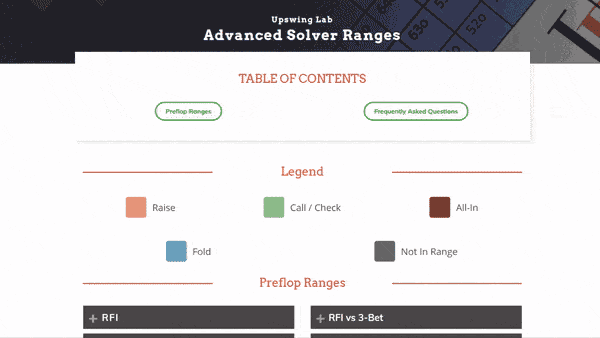
The Advanced Solver Ranges for cash games — one of five sets of preflop charts in the Upswing Lab.
Flop
The Pot: 7.5bb
The Flop: T♥️ 7♠️ 6♠️
The Action: Abdalah checks. Andy checks.
Flop Analysis
This board hits the in-position player’s range a bit harder, but the ranges are still pretty wide for both players.
Against the check, Dara suggested that Andy’s hand is a mix (bet sometimes, check sometimes) in a vacuum. With ICM factored in, however, it becomes an easy check back.
The downsides of this line, as Andy pointed out in the video, are two-fold:
- We do not protect a vulnerable bottom pair
- We fail to define our opponent’s range.
Conversely, though, we also keep the pot small by checking, which is still our primary objective with a marginal hand.
Turn
The Pot: 7.5bb
The Turn: (T♥️ 7♠️ 6♠️) 3♣️
The Action: Abdalah bets 6.1bb. Andy calls.
Turn Analysis
Abdalah’s 81% sizing is interesting. Andy believed that Abdalah would be inclined to bet smaller with a value hand. In any case, this bet size certainly polarized Abdalah’s range — he’s either got a strong value hand (like a slow-played straight or a turned set) or a bluff.
It’s possible that Abdalah is trying to put pressure on what he perceives to be a weak check-back range, either with a bluff or a thin value bet. Andy explained how his biggest concern was hands like 99, 88 and A7 which may now feel comfortable extracting value, which was certainly a possibility.
The consensus view was that Andy’s specific hand must call as there are far too many draws and air in Abdalah’s range to fold.
River
The Pot: 19.7bb
The River: (T♥️ 7♠️ 6♠️ 3♣️) 3♦️
The Action: Abdalah bets 21.25bb. Hills calls.
River Analysis
Abdalah polarizes his range again, this time with an overbet. He’s either got a bluff or a super-strong hand (trips, a straight, quads, or a boat). Because of that, our hand’s value is simply that of a bluff-catcher.
Let’s think through Abdalah’s potential value hands:
Straights seem unlikely, but not impossible given Abdalah’s decision to check the flop. 77 and 66 seem unlikely for the same reason. TT is plausible, but given the wetness of the flop, Abdalah may choose to bet that hand on the flop as well. 33 makes perfect sense, but there is only one combo of that. His range can, however, contain a lot of 3x.
Dara’s examination of the PioSolver output revealed that Abdalah could actually play his 10x and some 7x this way. But a line like that would be very sophisticated and so was heavily discounted by Andy.
This is actually a great bet size by Abdalah, whether by design or by accident. It puts Andy in a very tough spot and makes him indifferent with a variety of bluff-catchers.
In-game, Andy sensed correctly that this decision was very close from a theoretical perspective and, for that reason, he decided to look for a live read.
Believing that the population would under-bluff with 15 left in a massive field main event, Andy initially leaned towards folding. But a physical read of Abdalah, who surprisingly removed his shades after making the bet, ultimately tipped him back the other way.
Andy interpreted this action as a ‘fake strong’ tell and was more confident in that read moments later when he observed some ‘hard to fake’ anxiety tells. Andy ended up making the call, in a spot that could have gone either way.
Results
Abdalah mucked and Andy won the 61.7bb pot.
Wrapping Up
Andy Hills is a phenomenal live poker player who is one of the most traveled players on the international circuit. He has accumulated a lot of experience with a wide variety of players, making his ability to profile his opponents particularly sharp. In poker, however, there is a very fine line between astute profiling and artless bias.
Our primary method of decoding a game should always be a cold analysis of the hard facts but on occasion, this will lead us to a painfully close decision. The good news is that when a spot is on the knife-edge, it cannot be much of a mistake whatever we ultimately choose to do.
In these situations, leaning into the extra information available is wise. Online, we might have history with the villain and his tendencies could reveal themselves in his HUD stats. Live, we always have the option to interrogate our opponent and make them reveal their true comfort level.
In this high pressure spot, Andy did just that and that extra information ultimately tipped the scales in favour of a correct call that helped propel him to a major final table, where he came 6th for a €53,000 score.
What do you think of Andy’s play? How often do you lean into physical tells as a way to make close decisions?
Let us know in the comments below.
Check this tournament hand analysis out next if you haven’t already: $2 Million Up for Grabs — Can Dan Smith Get Fedor Holz to Fold?
Thanks for reading.
Note: Ready to join 6,000+ players currently upgrading their No Limit Hold’em skills? Crush your competition with the expert strategies you will learn inside the Upswing Lab training course. Learn more now!

